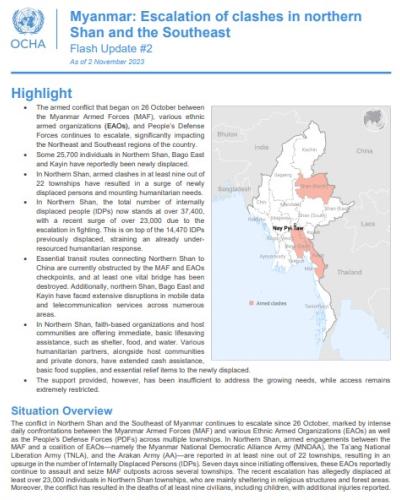Myanmar Earthquake Flash Update #2 (As of 31 March 2025)

Highlights
- Three days following the catastrophic earthquakes that struck Myanmar, search and rescue operations continue as responders race against time to save those who are trapped beneath collapsed structures.
- Current reports indicate that over 1,700 people died, more than 3,400 sustained injuries, and more than 300 people remain unaccounted for nationwide. The actual figures may be higher due to underreporting amidst disrupted telecommunications.
- A significant number of families have been rendered homeless, with many mourning the loss of loved ones, possessions and property in this widespread devastation.
- Humanitarian efforts continue with rapid needs assessment and emergency assistance initiated in the most severely affected regions.
- This disaster has exacerbated an already dire humanitarian situation, where, prior to the earthquake, 19.9 million people were in need of assistance. The resilience of affected communities is being severely tested as many have lost their livelihoods and means of survival.
Situation overview
Three days after the catastrophic earthquakes struck Myanmar, search and rescue operations remain in full swing as responders work tirelessly to save those trapped under collapsed buildings. While additional survivors have been rescued from the rubble, the death toll continues to rise. Latest field reports indicate that upwards of 1,700 people have died, over 3,400 are injured and more than 300 people remain unaccounted for nationwide. However, the actual numbers may be higher due to underreported cases, resulting from disrupted telecommunications. Local teams, supported by international rescue units, are intensifying their efforts, particularly in central Myanmar, which continues to experience aftershocks as of last night. Rescue teams from numerous countries including China, India and Russia are already deployed on the ground, with further assistance anticipated from other countries in the coming days.
The earthquakes resulted in the loss of lives and caused extensive destruction, reducing homes to rubble and severely damaging critical infrastructure. Numerous families are now homeless and have lost loved ones and their possessions in the devastation. Thousands of people in Mandalay, Sagaing, Nay Pyi Taw, and other affected areas are spending nights in the open – either because their homes have been destroyed or out of fear of further tremors. In the hardest-hit areas such as Mandalay City (Mandalay Region), Sagaing Township (Sagaing Region), Nay Pyi Taw Union Territory, and the townships of Kalaw, Nyaungshwe, Pinlaung, and Taunggyi in southern Shan, communities struggle to meet their basic needs, such as access to clean water and sanitation, while emergency teams work tirelessly to locate survivors and provide life-saving aid. With essential services disrupted and thousands in urgently needing shelter, health care and essential household items.
Preliminary assessments indicate a high number of trauma-related injuries necessitating immediate medical attention. Many survivors are suffering from fractures, open wounds and crush syndrome – all conditions that pose a high risk of infection and complications due to limited surgical capacity and inadequate infection prevention measures. The displacement of thousands into overcrowded shelters, coupled with the destruction of water and sanitation infrastructure, has significantly heightened the risk of communicable disease outbreaks. Vulnerability to respiratory infections, skin diseases, vector-borne illnesses such as dengue fever, and vaccine-preventable diseases like measles is escalating.
In the aftermath of this disaster, immediate child protection needs evolve rapidly; risks will likely escalate over the following weeks and months. Overcrowded living conditions, loss of livelihoods, and negative coping mechanisms can lead to increased domestic violence, child marriage, child labour and unsafe migration practices. Additionally, earthquakes can displace landmines and unexploded ordnance, shifting them into populated areas or previously safe zones, heightening risks for affected communities and making explosive devices more unstable and prone to detonation.
Humanitarian needs
- In central and northwestern Myanmar, inter-agency teams comprising UN system members and other humanitarian organisations are conducting rapid needs assessments across several townships in Mandalay and Kyaukse districts, and in Sagaing Township, as well as in Nay Pyi Taw Union Territory.
- In Nay Pyi Taw Union Territory, Lewe Township has reported severe damage alongside Pyinmana Township; Tatkon Township experienced major structural losses. More than 10,000 buildings – including public service offices – have collapsed or sustained severe damage. Urgent needs include emergency shelters (tents), WASH support (latrines, clean water), food supplies, non-food items (NFIs), healthcare services and first aid kits. In Mandalay District, varying degrees of damage have been reported in school infrastructure; some areas experienced major structural losses in Mandalay City and surrounding townships. Tragically, a private preschool was in session during the earthquake when its classroom building collapsed – resulting in the deaths of 50 children and two teachers.
- In southeastern Myanmar, seven townships across southern Shan, seven townships in Bago Region, and one township in Kayin State have been affected by the earthquakes. Initial findings indicate an urgent need for safe drinking water and sanitation facilities along with hygiene kits. Many communities are experiencing disruptions to their water supply systems – heightening risks for waterborne diseases. Partners are working diligently to dispatch essential supplies such as water purification tablets, hygiene kits and sanitation materials to affected areas while efforts are underway to establish functional local markets for safe drinking water.
- In southern Shan, 64 people died, and 90 others were injured across Kalaw, Nyaungshwe, Pinlaung and Taunggyi townships. The earthquake damaged or destroyed at least 3,560 houses and 28 hospitals in multiple townships. Over 13,000 people have been displaced, seeking refuge in collective centres and religious buildings – while others are forced to sleep in open spaces due to a lack of shelters. Urgent needs include emergency shelter solutions such as kitchen sets and mattresses alongside clean water provisions as well as food assistance coupled with essential healthcare services and psychosocial support.
- In Bago, 37 people, including six displaced children, have died while 176 others sustained injuries. The earthquake has damaged 168 houses along with two schools, a health clinic and 10 shelters within a displacement camp. Urgent needs include food, medical care and supplies and hygiene kits to support affected communities.



